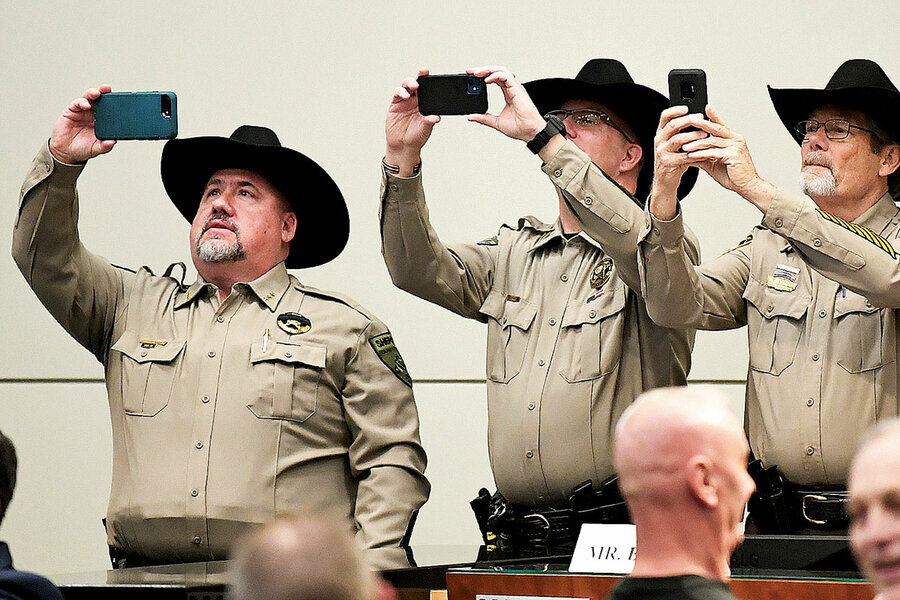Can you hear me now? Cellphones turn 50.
Loading...
The first cellphone call was a competitive triumph. On April 3, 1973, Motorola engineer Martin Cooper dialed up his rival at AT&T on a 2.4-pound prototype. He wanted his competitor to be the first to know that his team had successfully completed a working mobile phone.
That competitive spirit of innovation has catapulted the technology upward – and transformed society so much that it’s now difficult to think of life without cellphones.
Why We Wrote This
A story focused onFifty years ago, the idea of calling someone on a phone in your pocket was unthinkable – until it wasn't. Since the first cellphone call on April 3, 1973, the technology has continued to transform how people connect.
Mobile communication devices are never going to go away because humans are always going to want to stay connected, says futurist Brian David Johnson at Arizona State University. “The more technology we have, the more human we become,” Mr. Johnson argues.
But there is a flip side, says Joanne Orlando, a digital well-being specialist in Sydney, Australia. Most of the people she interviews tell her they are “addicted” to their cellphones.
She suggests asking yourself how your phone can work for you, instead of vice versa. “How,” she asks, “can you have such an amazing thing and not use it well?”
The first cellphone call was a competitive triumph. On April 3, 1973, Motorola engineer Martin Cooper dialed up his rival at AT&T on a phone that weighed 2.4 pounds and was the size of brick. He wanted his competitor to be the first to know that his team had successfully completed a working mobile phone.
It was just the beginning.
That competitive spirit of innovation has catapulted the technology upward – and transformed society so much that it’s now difficult to think of life without cellphones.
Why We Wrote This
A story focused onFifty years ago, the idea of calling someone on a phone in your pocket was unthinkable – until it wasn't. Since the first cellphone call on April 3, 1973, the technology has continued to transform how people connect.
How did cellphones arise and spread?
The cellular mobile phone Mr. Cooper used to make his call was the DynaTAC 8000X, requiring a 10-hour charge for a 30-minute call. It would be another decade before it was commercially available. In 1983, consumers could finally buy it for $3,995 ($12,000 in today’s money).
In 1992, IBM released the first smartphone, or a phone capable of performing the functions of a computer. Variations ensued: shrinking sizes, the flip phone, and the Blackberry. In a 2007 revolution, Apple combined touch-screen and other technologies in its iPhone, popularizing the smartphone as a handheld computer. The phone became a camera and a device for all manner of apps, not just for calls and texts. Developments have continued, led by Apple and Google’s competing Android platform.
Today, 85% of Americans own a smartphone, according to the Pew Research Center surveys. Globally, by some estimates, there are nearly as many active cellphone subscriptions as people on the planet. And the pace of growth in new mobile subscriptions, though slowing as smartphones become ubiquitous, has been above 5% annually in recent years.
Where will they go next?
To understand the future of the cellphone, it’s vital to understand its purpose as a communication device, says futurist Brian David Johnson at Arizona State University. “It’s really important to remember that at the center of this technology is people,” he says.
Phones already have changed forms countless times. What started as the size of a brick is now something you can wear on your wrist or in an earbud. It’s just going to get smaller and more convenient to use, Mr. Johnson says. It seems to be evolving toward incorporation into eyeglasses, virtual-reality headsets, or even chips implanted in (or “tattooed” on) one’s body. New forms of data display could include holographic images.
At the same time, advancements in artificial intelligence are also going to change the game, he says. Cellphone capabilities will continue to grow beyond question-and-answer digital assistants like Siri and Alexa. Your phone will know you and anticipate your needs. Our cellphones will become a personal assistant, says Mr. Johnson.
“They’re going to be your artificial intelligence. Your own autonomous technology,” he says. Scammers too will become more advanced – such as by imitating voices and visual appearances in a video.
Cellphone-type devices are never going to go away because humans are always going to want to stay connected.
“The more technology we have, the more human we become,” Mr. Johnson argues.
Are phones actually improving our lives?
It depends on whom you ask. In developing nations, cellphones have expanded job opportunities, access to education, and the ease of financial transactions and banking. A 2018 Gallup World Poll found that 79% of people in developing economies now own a mobile phone.
In fact, life without a cellphone is difficult to imagine for most, says Joanne Orlando, a digital well-being specialist in Sydney, Australia. A device that can keep track of work, texts, calls, and social media, and provide access to limitless information, is both a blessing and a curse, she says.
“The way I see it, it’s not an object that we own anymore,” says Dr. Orlando, who regularly interviews adults and teens about their technology habits. “It’s become part of who we are now. It’s like having another arm, it’s become an extension of ourselves.”
But the flip side, says Dr. Orlando, is that most of the people she interviews tell her they are “addicted” to their cellphones.
Recent studies find that teens especially struggle with technology overuse. The line between connection and over-connection, partly due to pressure from peers, can be blurry. Some Gen Zers are encouraging their peers to unplug from TikTok, influencers, and the like by bringing back the flip phone.
Amid habits of endless scrolling, Dr. Orlando suggests asking yourself how your phone can work for you, instead of vice versa.
“How,” she asks, “can you have such an amazing thing and not use it well?”








